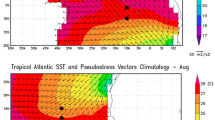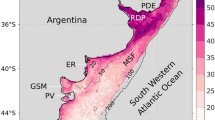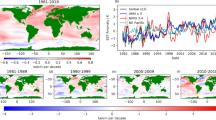Abstract
Based on the surface energy budget, the sea surface temperature (SST) variance is related to the product of three factors: the sum of the variances of surface radiative and turbulent energy fluxes and of ocean heat transport, an efficiency factor depending on the covariances among them, and a transfer factor involving the persistence of surface temperature via its lagged autocorrelation. These quantities are analyzed for current climate conditions based on results from the NCEP/NCAR reanalyses and a simulation with the CCCma coupled climate model. Potential changes with climate change are considered based on two quasi-equilibrium climate change integrations for which the forcing has been stabilized at years 2050 and 2100 values of the IS92a forcing scenario. The surface energy fluxes, which contribute to the variance of SST, are similar in the modelled and reanalyzed atmosphere but modelled temperature variance is conditioned on the thickness of the upper ocean model layer. Changes of SST variance with global warming show broad scale patterns with decreases in the tropical central-eastern Pacific and the northern extra-tropical Pacific, and increases in both the sub-tropical Pacific and mid-latitudes of the North Atlantic. The changes in SST variance are not associated only with changes in the variances of surface energy fluxes/transports but also with changes in the covariances among them and by changes in the temperature autocorrelation structure.















Similar content being viewed by others
References
AchutaRao K, Sperber K, CMIP Modelling groups (2002) Simulation of the El Niño southern oscillation: results from the coupled model intercomparison project. Clim Dyn 19:191–209
Alexander MA, Scott JD, Deser C (2000) Processes that influence sea surface temperature and ocean mixed layer depth variability in a coupled model. J Geophys Res - Oceans 105:16823–16842
Barnett TP (1983) Interaction of the Monsoon and Pacific Trade Wind System at Interannual Time Scales Part I: The Equatorial Zone. Monsoon Weather Rev 111:756–773
Bates GT, Meehl GA (1986) The Effect of CO2 Concentration on the frequency of blocking in a general circulation model coupled to a simple mixed layer ocean model. Monsoon Weather Rev 114:687–701
Battisti DS (1988) Dynamics and thermodynamics of a warming event in a coupled tropical atmosphere-ocean model. J Atmos Sci 45:2889–2919
Battisti DS, Hirst A (1989) Interannual variability in the tropical atmosphere/ocean system: influence of the basic state, ocean geometry and non-linearity. J Atmos Sci 46:1687–1712
Boer GJ, Yu B (2003) Climate sensitivity and response. Clim Dyn 20:415–429
Boer GJ, Flato G, Reader MC, Ramsden D (2000a) A transient climate change simulation with greenhouse gas and aerosol forcing: experimental design and comparison with the instrumental record for the 20th century. Clim Dyn 16:405–425
Boer GJ, Flato G, Ramsden D (2000b) A transient climate change simulation with greenhouse gas and aerosol forcing: projected climate for the 21st century. Clim Dyn 16:427–450
Boer GJ, Yu B, Kim SJ, Flato G (2004) Is there observationa support for an ElNiño-like pattern of future global warming? Geophys Res Lett 31:L06201; doi: 10.1029/2003GL018722
Cayan DR (1992a) Latent and sensible heat flux anomalies over the northern oceans: driving the sea surface temperature. J Phys Oceanogr 22:859–881
Cayan DR (1992b) Latent and sensible heat flux anomalies over the northern oceans: the connection to monthly atmospheric circulation. J Clim 5:354–369
Collins M (2000) The El Niño-Southern Oscillation in the second Hadley centre coupled model and its response to greenhouse warming. J Clim 13:1299–1312
van den Dool HM, Horel JD (1984) An attempt to estimate the thermal resistance of the upper ocean to climatic change. J Atmos Sci 41:1601–1612
Flato GM, Boer GJ, Lee W, McFarlane N, Ramsden D, Reader M, Weaver A (2000) The Canadian centre for climate modelling and analysis global coupled model and its climate. Clim Dyn 16:451–467
Folland CK, Parker DE (1995) Correction of instrumental biases in historical sea surface temperature data. Q J Roy Meteorol Soc 121:319–367
Frankignoul C (1985) Sea surface temperature anomalies, planetary waves and air-sea feedback in the middle latitudes. Rev Geophys 23:357–390
Frankignoul C, Kestenare E (2002) The surface heat flux feedback. Part I: estimates from observations in the Atlantic and the North Pacific. Clim Dyn 19:633–647
Frankignoul C, Czaja A, Heveder B (1998) Air-sea feedback in the North Atlantic and surface boundary conditions for ocean models. J Clim 11:2310–2324
Frankignoul C, Kestenare E, Botzet M, et al (2004) An intercomparison between the surface heat flux feedback in five coupled models, COADS and the NCEP reanalysis. Clim Dyn 22:373–388
Garreaud RD, Battisti DS (1999) Interannual (ENSO) and interdecadal (ENSO-like) variability in the southern hemisphere tropospheric circulation. J Clim 12:2113–2123
Hasselmann K (1976) Stochastic climate models. Part I: Theory. Tellus 28:473–485
Hnilo JJ, Santer BD, Boyle J, Taylor KE, Doutriaux C (1999) Research activities at the program for climate model diagnosis and intercomparison. The 2nd International Conference on Reanalyses, Reading
Hsieh WW, Tang B (1998) Applying neural network models to prediction and data analysis in meteorology and oceanography. Bull Am Meteorol Soc 79:1855–1870
IPCC (2001) Climate change: The scientific basis, Cambridge University Press, Cambridge, 881pp
Kalnay E et al (1996) The NCEP/NCAR 40-year reanalysis project. Bull Am Meteorol. Soc 77:437–471
Kistler R et al (2001) The NCEP-NCAR 50-year reanalysis: Monthly means CD-ROM and documentation. Bull Am Meteorol Soc 82:247–268
Knutson TR, Manabe S, Gu D (1997) Simulated ENSO in a global coupled ocean-atmosphere model: multidecadal amplitude modulation and CO2 sensitivity. J Clim 10:138–161
Kushnir Y, Lau NC (1992) The general circulation model response to a North Pacific SST anomaly: dependence on time scale and pattern polarity. J Clim 5:271–283
Latif M, Barnett TP (1994) Causes of decadal climate variability over the North Pacific and North America. Science 266:634–637
Levitus S (1984) Annual cycle of temperature and heat storage in the World Ocean. J Phys Oceanogr 14:727–746
Manabe S, Stouffer RJ (1994) Multiple-century response of a coupled ocean-atmosphere model to an increase of atmospheric carbon dioxide. J Clim 7:5–23
Marotzke J (1994) Ocean models in climate problems. In: Malanotte-Rizzoli P, Robinson A (eds) Ocean progresses in climate dynamics: global and mediterranean examples, Kluwer Academic Publishers, Dordrecht, MA
McFarlane NA, Boer GJ, Blanchet J-P, Lazare M (1992) The Canadian climate centre second-generation general circulation model and its equilibrium climate. J Clim 5:1013–1044
Meehl GA, Branstator GW, Washington WM (1993) Tropical pacific interannual variability and CO2 climate change. J Clim 6:42–63
Meehl GA, Wheeler M, Washington WM (1994) Low-frequency variability and CO2 transient climate change. Part 3. Intermonthly and interannual variability. Clim Dyn 10:277–303
Monterey GI, Levitus S (1997) Climatological cycle of mixed layer depth in the world ocean, 87 figs., US Government Printing Office, NOAA NESDIS. Washington, DC, 5
Pacanowski RC, Dixon K, Rosati A (1993) The GFDL modular ocean model users guide. GFDL Ocean Group Technical Report 2. Geophysical Fluid Dynamics Laboratory, Princeton, 46p
Peixoto J, Oort A (1992) The physics of climate, AIP, NY, pp520
Philander SGH (1990) El Niño, La Niña, and the Southern Oscillation. Academic Press, San Diego, pp293
Rasmusson EM, Carpenter TH (1982) Variations in tropical sea surface temperature and surface wind fields associated with the Southern Oscillation/El Niño. Monsoon Weather Rev 110:1103–1113
Reynolds RW, Smith TM (1994) Improved global sea surface temperature analyses using optimum interpolation. J Clim 7:929–948
Ronca RE, Battisti DS (1997) Anomalous sea surface temperatures and local air- sea energy exchange on intraannual timescales in the northeastern subtropical pacific. J Clim 10:102–117
Seager R (1989) Modeling tropical pacific sea surface temperature 1970–1987. J Phys Oceanogr 19:419–434
Seager R, Kushnir Y, Cane MA (1995) On heat flux boundary conditions for ocean models. J Phys Oceanogr 25:3219–3230
Tett S (1995) Simulation of El Niño-Southern Oscillation-like variability in a global AOGCM and its response to CO2 increase. J Clim 8:1473–1502
Timmermann A, Latif M, Grötzner A, Voss R (1999a) Modes of climate variability as simulated by a coupled general circulation model. Part I: ENSO-like climate variability and its low-frequency modulation. Clim Dyn 15:605–618
Timmermann A, Oberhuber J, Bacher A, Esch M, Latif M, Roeckner E (1999b) Increased El Niño frequency in a climate model forced by future greenhouse warming. Nature 398:694–697
Trenberth KE, Hoar TJ (1996) The 1990–1995 El Niño-Southern oscillation event: longest on record. In: Proceedings of the symposium on global ocean-atmosphere-land system (GOALS). Atlanta, pp84–87
Trenberth KE, Caron JM, Stepaniak DP (2001) The atmospheric energy budget and implications for surface fluxes and ocean heat transports. Clim Dyn 17:259–276
Wang W, McPhaden MJ (2000) The surface-layer heat balance in the equatorial Pacific Ocean. Part II: Interannual variability. J Phys Oceanogr 30:2989–3008
Wang W, McPhaden MJ (2001) What is the mean seasonal cycle of surface heat flux in the equatorial Pacific? J Geophys Res 106:837–857
WCRP (2000) Intercomparison and validation of ocean-atmosphere energy flux fields. WCRP-112, WMO/TD-No. 1036, pp 303
Yu B, Boer GJ (2002) The roles of radiation and dynamical processes in the El Nino- like response to global warming. Clim Dyn 19:539–553
Zhang Y, Wallace JM, Battisti D (1997) ENSO-like interdecadal variability: 1900–1993. J Clim 10:1004–1020
Acknowledgments
We greatly appreciate the work of G. Flato, D. Ramsden, C. Reader, W. Lee, and other colleagues in the production of the model results analyzed here. We are also indebted to S. Lambert for his help in the NCEP data processing, to C. Frankignoul and E. Kestenare for the helpful discussion in calculating the heat flux feedback, and to M. Alexander for leading us to useful references in estimating the observed mixed layer depth. Comments from W. Merryfield, E. Schneider, X. Wang, and two anonymous reviewers are much appreciated. B. Yu has been supported partially by the Canadian CLIVAR Research Network.
Author information
Authors and Affiliations
Corresponding author
Rights and permissions
About this article
Cite this article
Yu, B., Boer, G.J. The variance of sea surface temperature and projected changes with global warming. Clim Dyn 26, 801–821 (2006). https://doi.org/10.1007/s00382-006-0117-9
Received:
Accepted:
Published:
Issue Date:
DOI: https://doi.org/10.1007/s00382-006-0117-9




